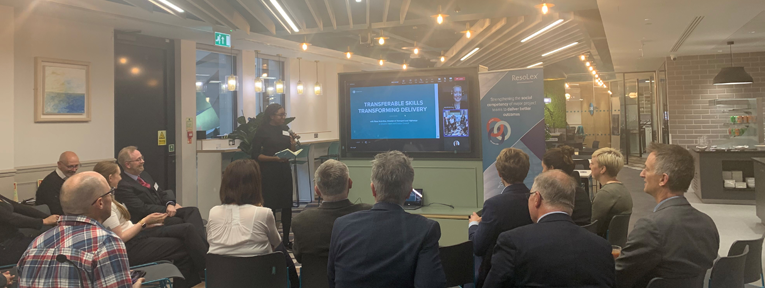
Nov 7, 2022 | Events, Roundtables
With guest speaker Rose McArthur, Director of Transport and Highways for Cheshire West and Chester Council and facilitated by Kelachi Amadi-Echendu, ResoLex
Kelachi opened the session with some background on ResoLex, explaining one of our underlying observations; projects rely on a triumvirate of competencies, technical, commercial and social. To set the landscape further, she highlighted a general challenge for lack of skills within the infrastructure sector. The skills problems begins at a high-level, so we have a technical challenge in areas such as climate change, as well as the economic challenges that organisations are wrestling with in a post-pandemic environment. The social component of major projects mentioned earlier encompasses these leadership challenges. The theme of the session was therefore to consider how we can bring people-oriented skills into the industry from other sectors whilst still appreciating the technical skills with career developments that aren’t necessarily leadership.

Rose started her presentation by talking about her own journey from being a Senior Consultant in a large engineering company, to a very different role in a local authority. Her background in integrated transport planning gave her the opportunity to work on huge projects such as the 2012 London Olympics, keeping people moving despite the challenge with an influx of people.
In her new role, she now has to focus on the practical problems within the highway sector exemplified by issues such as potholes, gulleys and pigeons. Many of the problems are much smaller in scale but there are huge amounts of them. Although Rose has a Director role and needs to strategically plan for the council’s transport and highways, many public enquiries are escalated to her due to a lack of communication from the project level and out to the local community.
Cheshire highways are a £5 billion asset, so there are many miles of road infrastructure that must be managed within very tight financial constraints. Rose made the point however that her biggest challenge is actually the people – as is the case in many engineering-focused teams, the historic basis for promotion is time served and technical expertise. Little concern has ever been paid to the skills of being customer focused and focusing strategically on future needs. All too often teams within the organisation have a silo mindset, and it is therefore difficult to get them to engage in new concepts outside of their core areas of expertise. So when it comes to management skills, technical competency is probably only around 25% of what is needed. Instead, there is a critical need for skills in communication, people management, delivering change, and the ability to engage a wider stakeholder group. Of course, some people with these technical skills may thrive in leadership and management roles but only with the right effort put into training – these important skills need development and training.
In developing her teams, Rose has found that she must therefore expand her search horizons when looking for new recruits. For example, she believes that change starts with the data-led approach, so the ability to analyse and communicate trends and issues is critical. She is also seeking people who have effective communication skills so that stakeholder relationships can be managed more effectively. More often than not, she has to go outside of the organisation to look for people in other sectors and industries to get the less technical but more strategic types of people to therefore reach the balanced team she requires.
Thoughts and observations from the floor included the following:
- An example was given of the huge value provided by somebody who had a passion for the environment but who originally came from a role in finance.
- Bringing in new skills and perspectives is important, but to be successful organisations need to be ready for the disruption they may cause. For example, construction firms are often not comfortable with people who are trying to push a different way of thinking.
- Leadership is critical in changing mindsets and behaviours. An example was given from a major programme where one of the senior leaders attended the sustainability group which significantly boosted attendance and output.
- There is a distinct leadership skill set around managing complexity and ambiguity.
- Creating resilient teams is one of the keys to survival in the 21st century, where leaders surround themselves with people who support each other in pursuit of a common goal.
The underlying message from the session is that in organisations that need to change, there needs to be a shift in the types of skills and competencies that may not be present in the current structure. The technical element which used to be dominant in many engineering-oriented businesses are still important, but at leadership, the level must often be subordinated to the ability to manage the problems created by complexity, scale and pressure on resources. The challenge for all organisations involved in infrastructure is to identify the different skills needed and create an environment which will encourage bright people to come and join them.

Oct 25, 2022 | Events
Event partner and Keynote speaker at the Rail Forum’s Infrastructure Collaboration event

Collaboration is a major buzzword in project delivery – and reasonably so, as more people recognise that it’s a key component of success. The challenge for many of us, is what does it look like in practice?
At ResoLex, we embed collaborative environments to deliver better outcomes on major projects. Our approach helps teams and project leaders manage the complexity of large-scale projects using a combination of behavioural theory, technology and industry experience to co-create new solutions to old problems.
The Rail Forum‘s ‘Infrastructure Collaboration – A Route to Success’ event aims to explore what collaboration means, and what it might look like in the rail infrastructure environment. With a topic so close to our hearts, we’re super excited to be an event partner and are delighted to share our experience and the industry insight we’ve built over the last 20 years with you all.
If you’re thinking of coming, we’d be delighted to see you! If you haven’t registered yet, you can use the link below:
https://www.railforum.uk/events/infrastructure-collaboration-a-route-to-success/
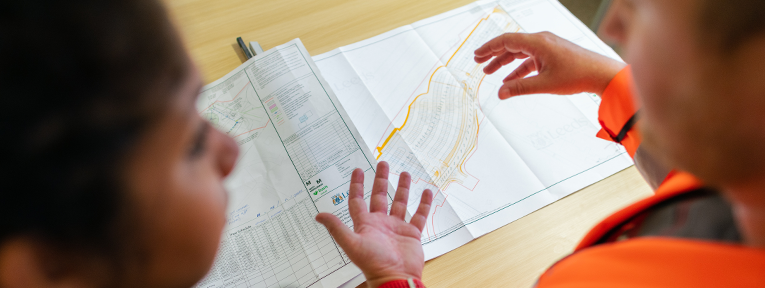
Aug 15, 2022 | Tools
Purpose: Tap into your team’s potential to solve complex problems
Time required: Initial half-day workshop, then interim follow-up work over the next six months
The theory behind the resource: The traditional approach to problem-solving on large projects is to rely on the knowledge and experience of individual experts. However, we are coming to realise that when faced with the often complex and ambiguous issues that are a feature of 21st-century, projects require a different way of thinking. The solution is to tap into the power of human ingenuity by using the collective thinking power of a diverse group. Teams can therefore provide an invaluable mechanism for finding new and effective solutions to difficult problems.
Accessing the collective intelligence of a team is, however, easier said than done. Assembling a group of bright minds does not mean they will generate any new thinking. There are a number of barriers which inhibit the truly open discussions that are needed. Miscommunication, a lack of appreciation of each other’s mental filters, outsized egos, and internal rivalries all diminish thinking capacity. To build collective intelligence, teams often need to learn, through training and group coaching, to be able to understand their limiting factors and how to work around them.
The process: The first step is to set up a half-day workshop, or to include the following activities as part of a team development day. The workshop comprises of three sessions.
Part One – Seeing different perspectives
The first part of the journey is to help team members recognise they have different ways of thinking. One of the fastest ways to do this is to use a simple psychometric that will help identify different motivations or preferences that will shape each person’s perspectives. Our preference is SDI (Strength Deployment Inventory) because it is quick to administer, easy to absorb, and most importantly easy to memorise. Having sent out the online tests the week before the team should arrive at the workshop aware of their own psychometric profile. The facilitator can then focus the team on the differences that are likely to emerge from each of the main profiles. The purpose of this first session is to engage the team members in a discussion that begins to help them see the potential value in having different perspectives when compared with the limitations that come with a single point of view.
Part Two – Formative experiences
How we behave in a working environment is also influenced by our previous experiences, both positive and negative. The second part of the workshop requires the team to split into groups of two or three people. Each person is then allowed five minutes to talk about what they remember as an important experience that has shaped how they think or make decisions. This could be personal or it could be professional. Once each person has had the chance to share, their counterpart must then provide a shortened (two minutes) summary of what they have heard, to the rest of the room. The value of this exercise is that it begins to deepen the types of conversation that can take place between team members helping them to understand what matters to each person and why.
Part Three – Understanding the need for psychological safety
A team is unlikely to harness its collective intelligence if some of the members do not feel psychologically safe. In other words, every person around the table feels sufficiently comfortable to be able to express their thoughts without fear of ridicule or retribution. This is easy to understand in theory, but how does it work in practice?
This is a short exercise where the concept of psychological safety is explained. Having allowed some time for questions, each team member is asked to spend five minutes thinking about the concept and to make a note of their thoughts around the following questions:
- When do I feel most safe in a meeting?
- When might I be uncomfortable?
- What could we do as a team to improve our sense of safety?
- How do we get better at challenging each other’s thinking without creating an intimidating atmosphere?
The facilitator then goes around the table, taking each of the questions, in turn, explains their thoughts without interruption, summarising their points on a flip chart. Once each person has spoken the team can then have a short discussion before moving on to the next point.
Part Four – Next actions
To close off the session, the team should spend 10 minutes identifying a series of actions they will take forward in future meetings.
Notes:
These exercises will not in themselves automatically improve the team’s Collective Intelligence. They will however your team the foundation upon which to build a more effective way of thinking as a genuine team. The key point to emphasise is that in a complex environment, there are few simple answers. Indeed one of the dangers teams face is to try and oversimplify an issue by simply ignoring the other elements that create complexity.
Part of the underlying learning from the above exercises should be that no single member of the team has the full answer, but each member of a team potentially has a part of it. Teams who can learn the humility to accept this have a much better chance of finding novel and practical responses to the challenges of 21st-century problems.
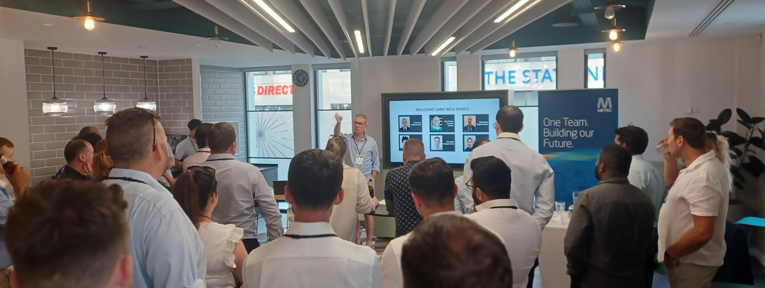
Jul 29, 2022 | Events
Last week, the team from Metro Trains Melbourne (MTM) travelled 10,497 miles and we couldn’t wait to welcome them to our new offices for an amazing networking event! All the way from their offices near St Patrick’s Cathedral, Melbourne to ResoLex HQ by St Paul’s Cathedral, London.
MTM are on a mission to recruit some amazing new talent to relocate and join them on some exciting projects in Victoria. Planning an event so far away can be difficult so we joined forces with Rail Media and NAWIC (National Association of Women in Construction) to help plan and execute the perfect networking and recruitment event.
Why did we become an event partner?
“Having worked with several of the MTM leadership team members in the UK, we were keen to support their international learning opportunities and foster international collaboration.
We joined MTM as their event partner as we know major projects worldwide require the same key elements to ensure success; technical competence, commercial competence and what we term social competence. Metro Trains Melbourne are offering the opportunity for project professionals to share learning from Crossrail and HS2 (High Speed 2) to this exciting urban transport project ‘Victoria’s Big Build’.
We are particularly interested in the impact of the alliance agreement, preferred in Australia when it comes to creating the integration required for successfully deploying the rail systems.
Therefore we were delighted to meet Pete Gleeson, Executive Director, and catch up with Jamie Burns and Lisa Hogben when they said they were coming to the UK on a learning mission and support their offering of opportunities to those who fancy the adventure of relocating to work with Metro”.
Edward Moore, Chief Exec. at ResoLex
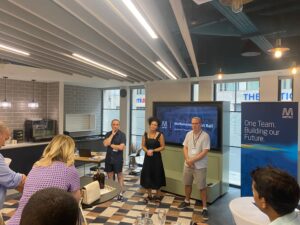
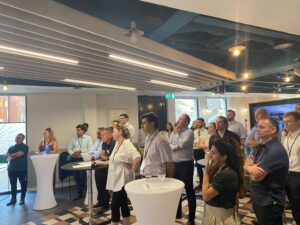
The event was a great success for MTM and those interested in relocating! We are keen to support like-minded organisations in major projects who are working to build diverse and collaborative teams. We caught up with Lisa Hogben, Package Director at Metro Trains Melbourne for some feedback on the event and here’s what she had to say:
Having worked with ResoLex in the past, enjoyed their innovative and creative professional development events and seeing how they live their values of insight, creativity, and partnership, I knew they were the right partners for our UK networking event.
To me, the essence of true collaboration is doing things for others even if there’s no immediate benefit to you, and ResoLex models that essence.
We’re so thankful that ResoLex agreed to be our event partners, and we definitely owe them one!
We would like to thank everyone involved and wish those relocating every success in an industry close to our hearts! Get in touch if you would like to see how we can help your project team.
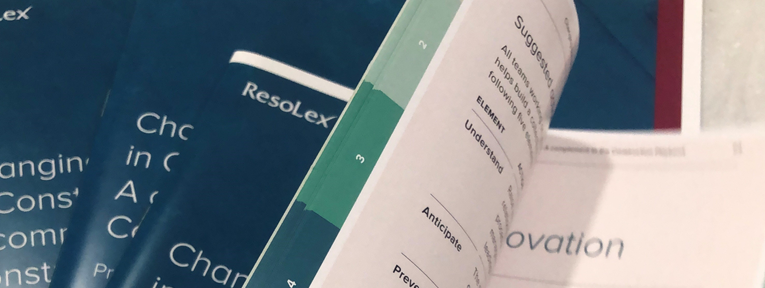
Jul 12, 2022 | Events, Roundtables
Putting The Construction Playbook into Practice – 30th June 2022
Facilitated by Ed Moore and Kelachi Amadi-Echendu
ResoLex’s Roundtable series recommenced with our first in-person session since Autumn 2019 and in our new home – you may have seen, we have relocated along with our friends from the International Dispute Resolution Centre to Paternoster Lane right next to the beautiful St. Paul’s Cathedral – where we welcomed a select group to delve into some of the key aspects of The Construction Playbook.
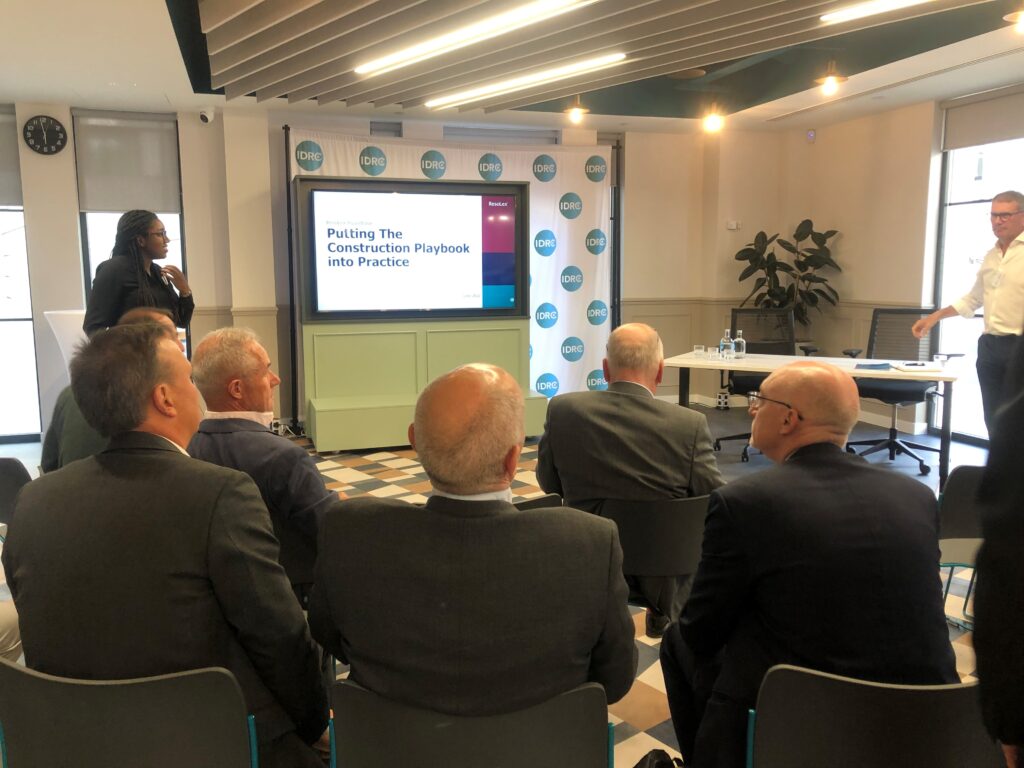
Our Chief Exec, Ed opened the session by setting out our view that the success of major projects hinges on three critical interlinked elements; Technical, Commercial and Social. His observation is that The Construction Playbook continues the worthy objective of modernising the construction industry. However, reading through the document one can see that its focus is primarily on a project’s technical and commercial elements, but has little to say on the social element, on the people that deliver projects.
Our Senior Consultant, Kelachi then introduced the report we recently produced, Changing Behaviours in Construction: A complement to The Construction Playbook. The report brings together our experience and contributions from our Associates and is designed to act as a complement to The Construction Playbook. It provides practical guidance on the behavioural and cultural elements that supplement some of the key recommendations in the Playbook, focusing on actions and activities that we know through our experience help to build a project’s ‘social capital’.
Our Roundtable sessions are designed to be an interactive discussions rather than a lecture. We, therefore, had an interactive session with participation from everyone in the room, offering a range of perspectives around two key topics:
- Collaborative Leadership
Leadership has been a hot topic within the industry lately. Kelachi pointed out that it is discussed throughout our report and was recently raised in the second iteration of the ICE review: A Systems Approach to Infrastructure Delivery. An article in the NCE references the report as identifying the need for projects to move on from the habit of appointing ‘hero leaders’ – you can find the full article here.
There was consensus in the room that when faced with complexity, there is a need to adopt different leadership styles and attributes and, that collaborative leadership is desirable, but it is probably more important to embed the right culture at the start. The discussion also brought out the recognition that the leadership needs of a project change as the project/programme moves through the cycle. In modern construction, leaders need to be truly agile, and able to adjust their approach depending on circumstances.
- Front End Loading
Ed picked up on the requirement in the Playbook to put more time into the start of a project to think through how a team will work together before moving into the task of construction. The question to the room was the extent to which this would add value.
The consensus was that time spent working through potential issues with the full design and delivery team, ideally producing a digital twin, would ultimately produce a better outcome. The proviso, however, was that project teams need to be clear on the main focus, as time can easily be frittered away on inconsequential matters.
The other challenge identified is that upfront investment in building relationships could be wasted if individuals involved in the early stages of a project then quickly moved on to other projects or roles. The answer to this problem was seen to be the need to proactively establish a strong culture so that new entrants to the project would quickly pick up the required mindset and behaviours set out in the beginning.
Summary
Taking an overview of the evening’s discussion, the common perspective was a recognition that the social, and therefore people component is a key element in the shifting of behaviours to enable the construction industry to deal with the complexity and uncertainty that are features of our current environment. The industry must therefore focus more effort to train leaders in how to become more agile and understand how to build project cultures that will embed collaborative ways of working that will endure through the life cycle of a project.
You can access The Construction Playbook and our report through the links below:

The Construction Playbook
Changing Behaviours in Construction: A complement to The Construction Playbook
Tony Llewellyn – 4 July 2022










